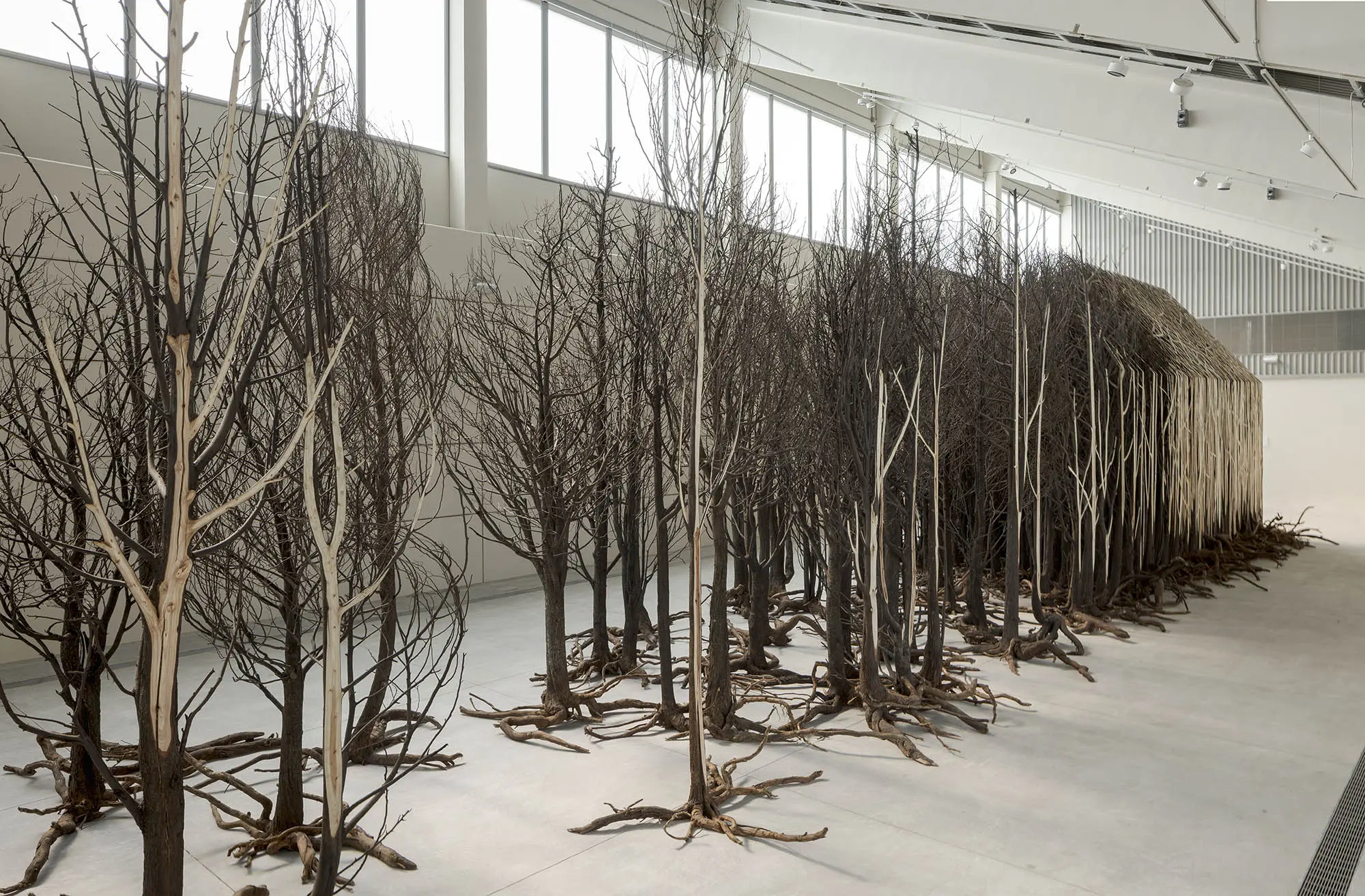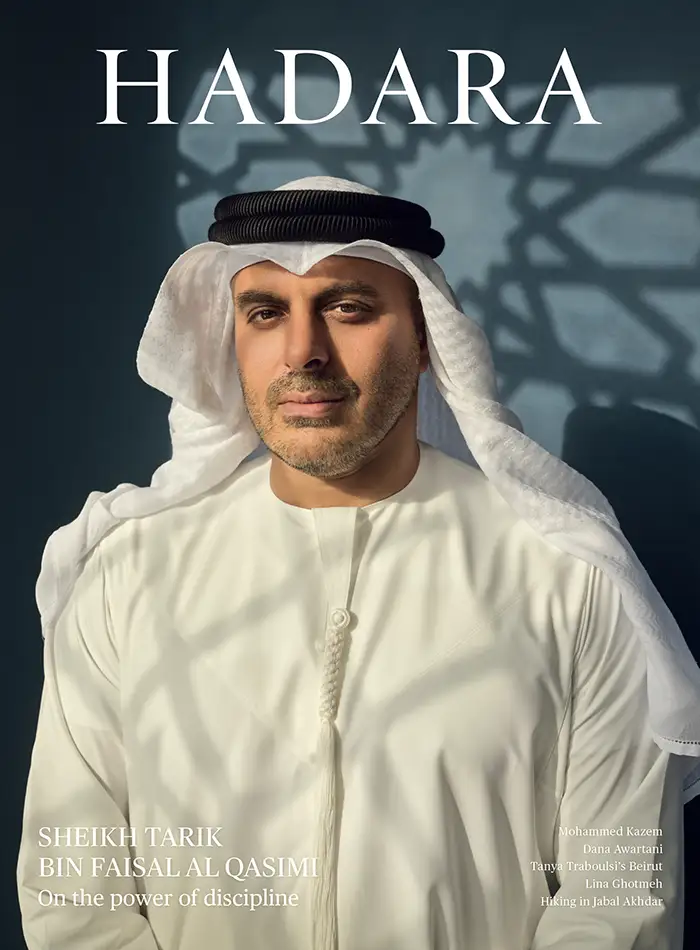Engines of meditation
With more than 300 works by over 150 artists and collectives from over 70 countries, Sharjah Biennial 15 opens visitors’ eyes and minds to fraught topics.
By Anna Seaman
Serving as a makeshift shade from the pervasive sunshine on Sharjah’s east coast, Ibrahim Mahama’s installation on the outer flank of Kalba Ice Factory had visitors squinting upward. A Tale of Time and Purple Republic (2023) is a convergence of several elements of the Ghanaian artist’s practice pulled together over much of the last decade. It consists of an 80 x 9 meter swathe of dark grey cloth, upon which traditional handwoven smock fabrics were sewn, the entire piece was then threaded through an enormous, purpose-built metal loom. Despite its almost overwhelming size, the artwork gave off a gentle presence as it caught the breeze coming from the nearby mangroves.
Viewers ponder its symbolism. The sometimes threadbare smocks adorning the larger cloth are traditionally passed down through generations and so, within their fibres, they hold the stories of decades. In assembling them in a single work upon new fabric, the artist is commenting on how identity is formed. On the one hand, we fashion ourselves on those who came before us, our inner selves woven by generations of tradition and culture that predate our existence. On the other, with modern travel or migration, our identities morph and wander depending on our paths. The work, a Sharjah Art Foundation commission, is one of three pieces Mahama is showing at Sharjah Biennial 15, which opened in February. His practice grapples with globalisation, colonialism, injustice and trade—themes that appear multiple times.
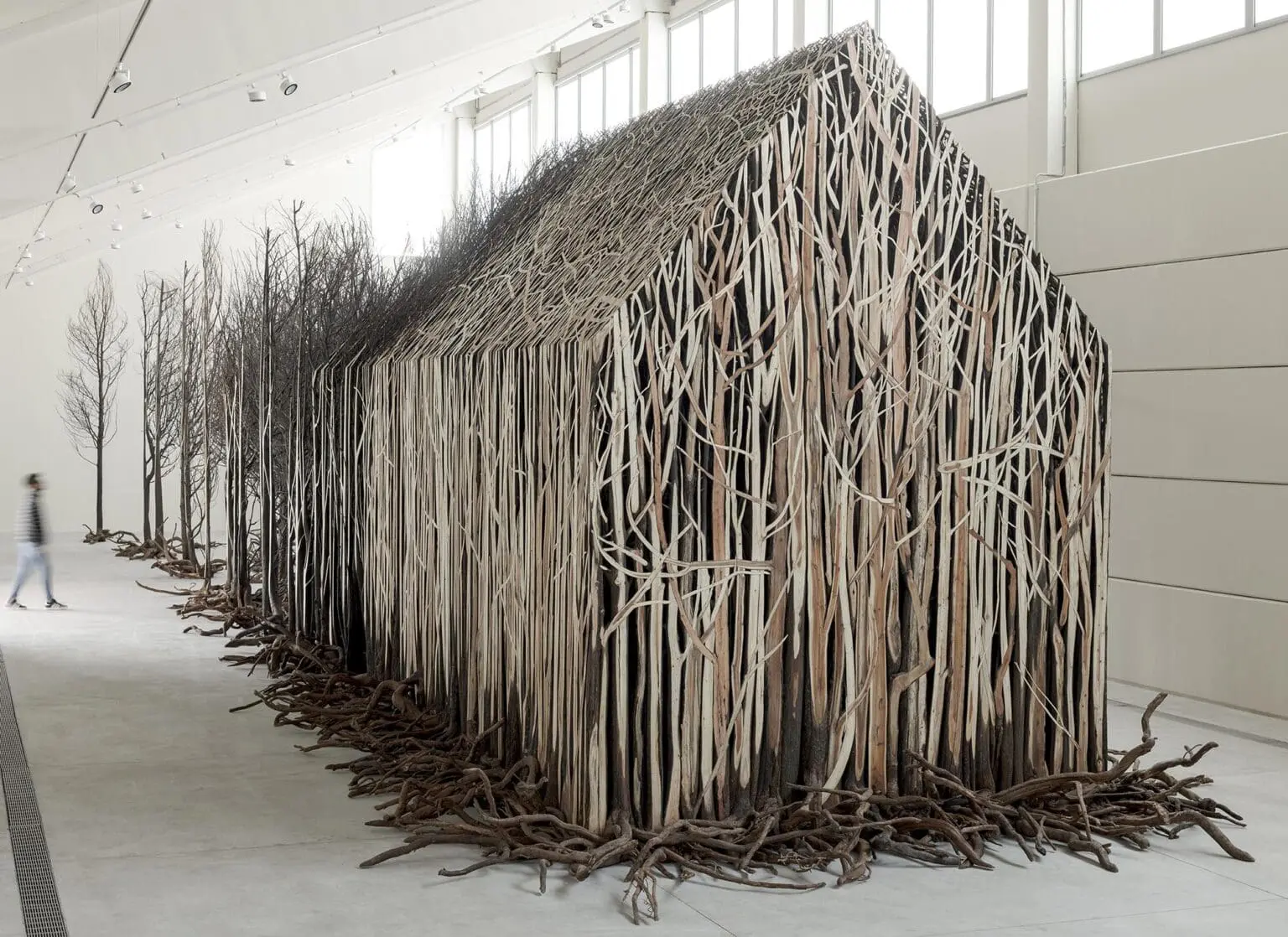
Among 30 artists commissioned to make new work for SB15 is Colombian sculptor and artist Doris Salcedo. Uprooted (2020-2022) is made from more than 800 dead trees. The work is a testament to the refugee’s predicament: permanently impermanent. Photos: Juan Castro Photoholic. Courtesy of the artist.
Spanning 19 venues and five cities and towns in Sharjah, the biennial underscores a message of togetherness, even if the stories presented are from the far corners of the world. Whether it is political turmoil in the Philippines, decades-long simmering tension in Palestine, the struggle of Maori women in New Zealand, or the challenge of exile, in all the stories we find solidarity.
“This biennial has no beginning and end. There is no direct route,” Sheikha Hoor Al Qasimi, president and director of Sharjah Art Foundation, said in her introduction. “I am interested in different viewpoints and it is very important that this biennial gives you many experiences and comes full circle with the same messages of power and solidarity, strength and friendship.”
Sharjah Biennial 15: Thinking Historically in the Present, under way until June 11, has been more than four years in the making. Originally slated for 2021, the event was suspended by the Covid-19 pandemic. Even more fraught was the loss of its mastermind, Okwui Enwezor, an influential Nigerian curator whose visionary work was aimed at shifting the gaze of Western art audiences towards the Global South. Enwezor died in 2019 at the age of 55 after a battle with cancer, and this biennial is his final work. Sheikha Hoor picked up the curatorial reins to realise Enwezor’s vision. This year is a notable one for her, too, marking two decades that she has been the biennial’s director. During the opening remarks for SB15, Sheikha Hoor paid tribute to Enwezor by reading from one of his text messages to her:
“I see the Sharjah Biennial as a unique model that grew from a biennial to institutionalisation, and the institution that emerged from that has provided a context of thinking and understanding about the pervasive challenges of art and the art worlds and cultural spheres from which art emerges. You also engaged deeply, in a manner that is not superficial, with the problems of understanding that often bedevil contemporary art. It’s a problem from which misunderstandings arise and in which blind spots persist, and for which you have built engines of mediation and historical, cultural, artistic, pedagogical, and discursive amelioration.”
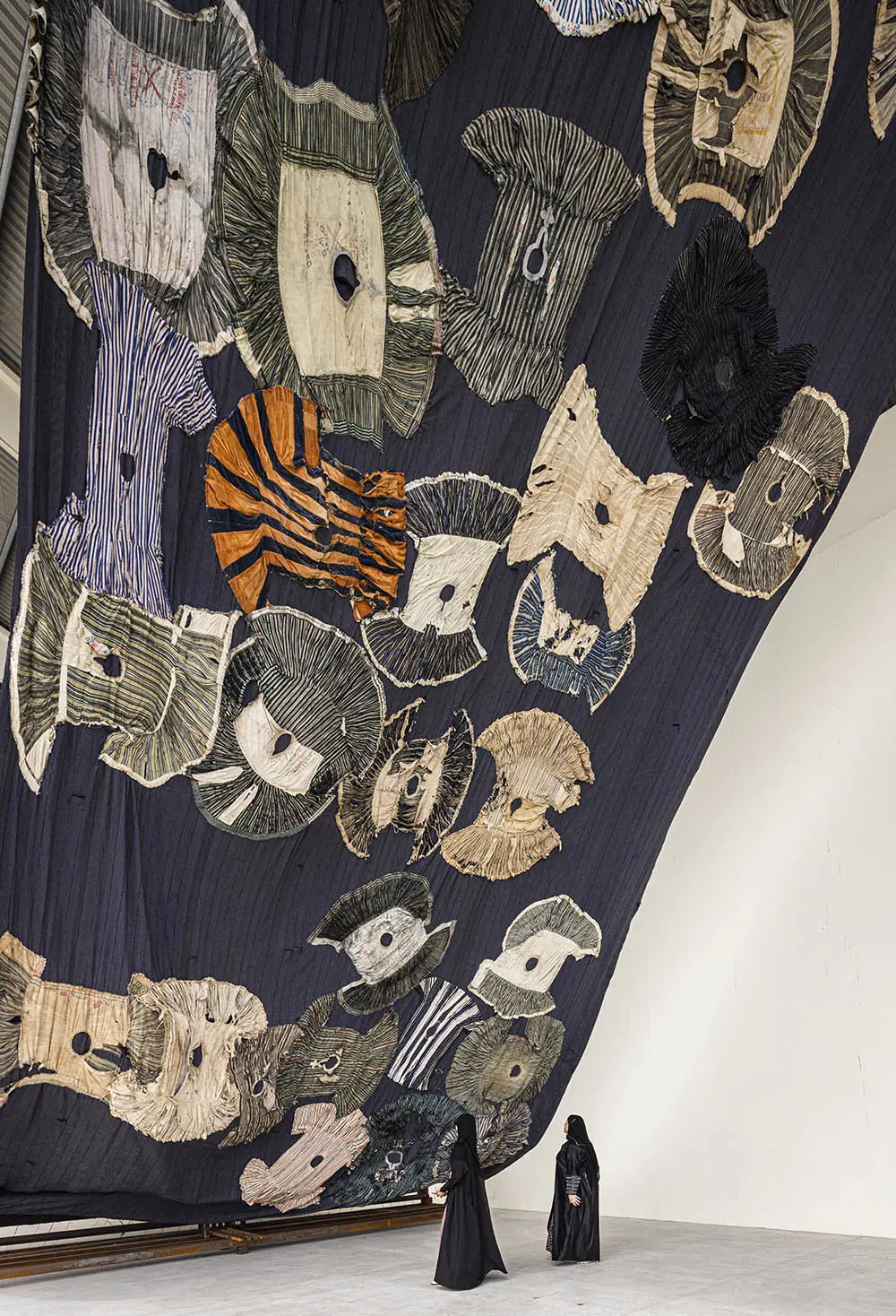
A Tale of Time and Purple Republic (2023) by Ghana’s Ibrahim Mahama. His practice grapples with globalisation, colonialism, injustice and trade. This is one of three pieces Mahama is showing at SB15. Photo: Ruksana Hussain.
The old ice factory in Kalba opened this year after renovation by Peru-based studio 51-1 Arquitectos, creating 20,000 square metres of exhibition space. One of its galleries houses Colombian artist Doris Salcedo’s unforgettable Uprooted (2020-2022). Made from 804 dead trees, it takes the form of a house at one end and dissolves into a forest of dead trees at the other. At once rootless and persistent, fragile yet strong, the work is a testament to the refugee’s predicament: permanently impermanent. It was one of three works awarded for outstanding contribution to the biennial. Another work in Kalba, Duty Colossus (2022) by Nari Ward, is constructed of long, roughly cut wooden panels. The monumental sculpture evokes the makeshift structure of Jamaican fishing villages but feels like a portal to another dimension.
Some of the settings couldn’t be more perfect for the artists’ messages. At an abandoned kindergarten in Kalba, for her work Threshold (2022), Afghan artist Hangama Amiri has hung swathes of black fabric—representing the garments women and girls are forced to wear by the Taliban regime—over school desks, symbolically telling the story of the artist, who was banned from formal education at the age of six by the Taliban.
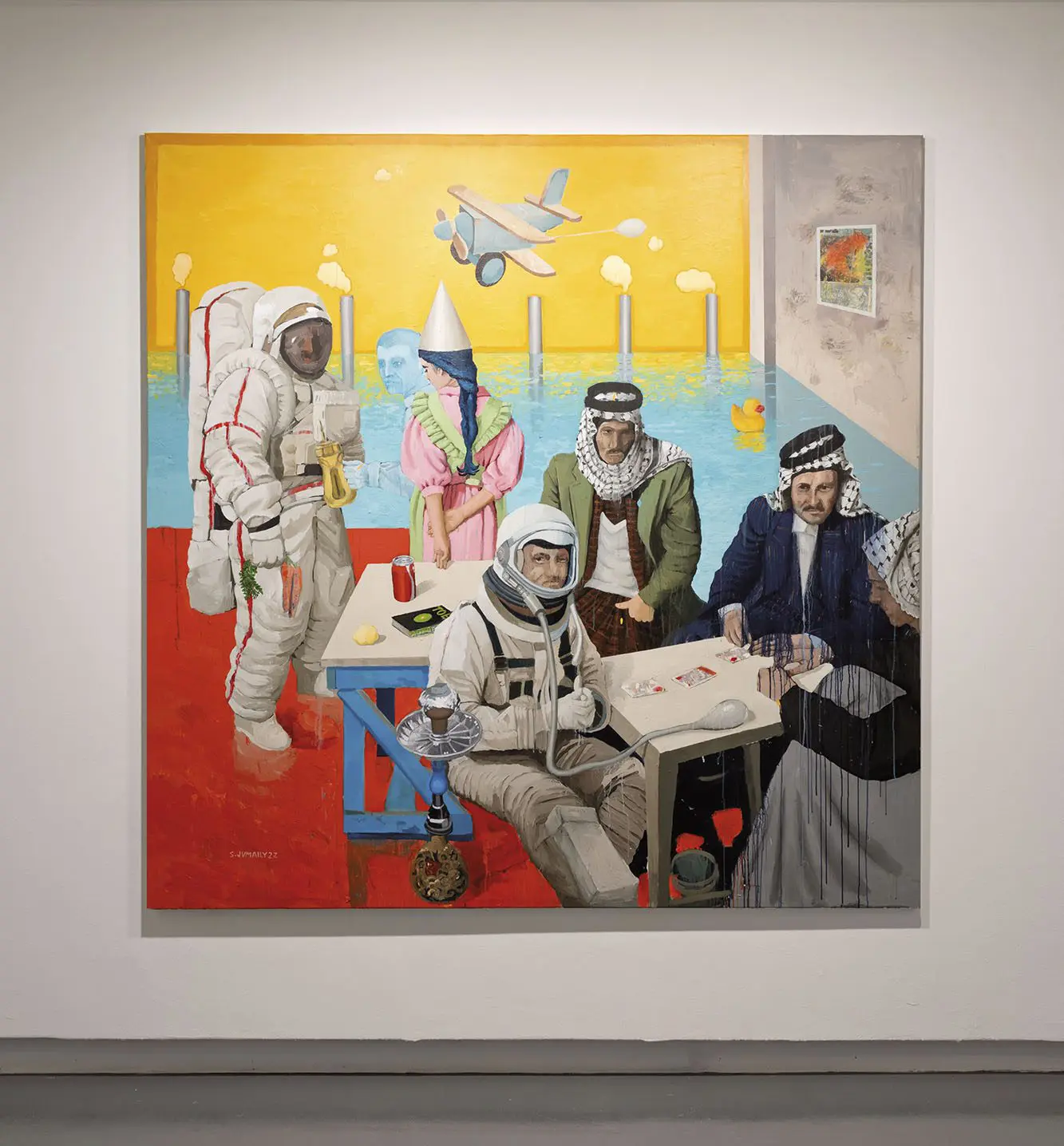
Iraqi artist Saddam Al Jumaily’s Unfair Game (2022). His surrealist works deride the future for Iraqis in the chaos of a war-torn country. Photo: Shanavas Jamaluddin courtesy of Sharjah Art Foundation.
In Sharjah City, at the Sharjah Art Museum, stories of adversity play out from around the world. Robyn Kahukiwa, whose resistance paintings address power plays and the erasure of traditions in Maori culture in New Zealand, presents 50 years of her works. Jawad Al Malhi’s portraits of Jerusalem’s youth are as sapped of colour as his subjects are drained mentally and physically by their perpetual wait for change. Nearby, Saddam Al Jumaily’s surrealist works deride the future for Iraqis in the chaos of a war-torn country. Kimathi Donkor’s portrayal of the race riots between police and young British Black men in Brixton in the 1980s and Hiroji Kubota’s reportage on the Black Panther Party in 1960s US both remain poignant decades later. Varunika Saraf’s complex retelling of the histories of South Asia—maps sewn by hand, where words describe events of the past, some significant, others private memories—are delicate and strong.
Much of the biennial, even when not talk-ing of real events, explores the relationship between past and present, closely linked with the biennial’s title, which was taken from Enwezor’s discussions about time and memory in a post-colonial world. In a former swimming pool at Sheikh Khalid bin Mohammed Palace in Al Dhaid, Kader Attia’s installation, Le Grand Miroir du Monde [the great mirror of the world] (2017) uses thousands of shards of mirrored glass to reflect an “eternal present” that overshadows memories of the past. In Bait Al Serkal, for her work The Myth of Eternal Life (2020-2022), Zohra Opoku explores the dichotomy between the solid yet fleeting nature of life with a work resembling a papyrus scroll, made at a weaving factory in Senegal. In it, she links ancient Egyptian funeral practices with her own healing journey from illness. In Khorfakkan Art Centre, Emirati artist Farah Al Qasimi’s project, a film about the ghost of a pirate who died defending Ras Al Khaimah in a siege and told by a genie (or jinn) known as Umm Al Dhabab (Mother of Fog), embraces myth whilst also pointing to the inescapability of the past.
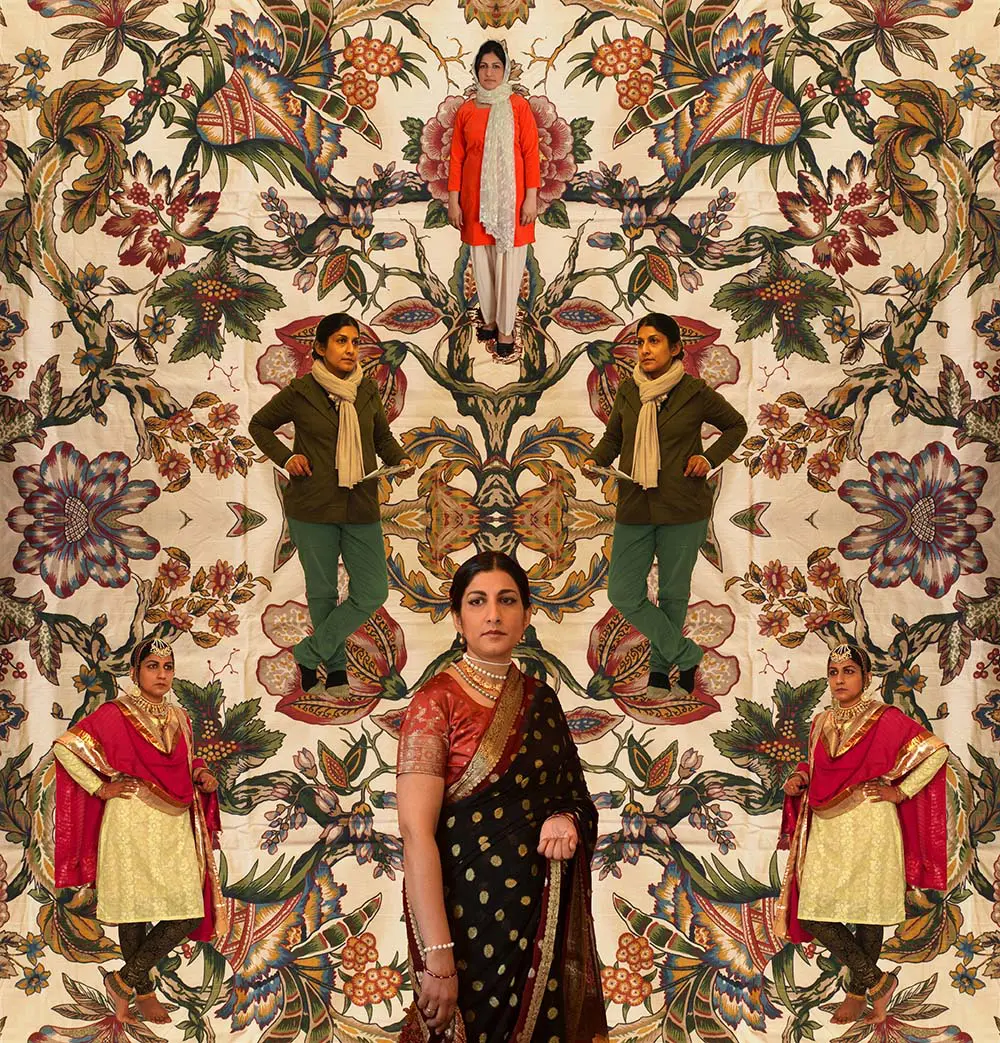
Nusra Latif Qureshi, The Ideal Floral Background (2013). Qureshi references the traditional art of South Asian miniature painting in her art practice. Her practice ranges from small and highly detailed paintings to large scale digital prints that engage with the visual histories of the South Asian region. Photo: Courtesy of the artist and Sutton Gallery, Melbourne
In Bait Obaid Al Shamsi, Shiraz Bayjoo also ventures into tales of pirate kingdoms with his installation Searching for Libertalia (2019), exploring the process of African independence in the context of Daniel Defoe’s 1724 book about the history of pirates. “I am thinking about the cycle of history,” says the Mauritian artist, who is participating in the biennial for the second time. “My practice explores unionism versus independence and the ongoing nature of that. It tries to open up the layers of these narratives that have not been told from this viewpoint before.”
Retelling history through the eyes of those who have experienced it and reclaiming a past that is lost in time is the overarching message of this biennial. Within each sensitively curated presentation, miniature stories unfold into one another.
“Foregrounding emergent, primarily non- Western institutional practices and priorities, the ethos of Sharjah Biennial is pluricentric and polyphonic and therefore calls for non-traditional modes of curation,” Sheikha Hoor writes in her curatorial essay. It is a statement of who she has become as a curator, and how she has positioned Sharjah as a place for cultural exchange and intersection that not only attracts the international art world but continually engages the local community.
Nurturing Arab Art
Since the Venice Biennale opened its doors 127 years ago, biennales have proliferated globally. In the Arab world, they have nurtured an ecosystem for contemporary art.
By Catherine Mazy
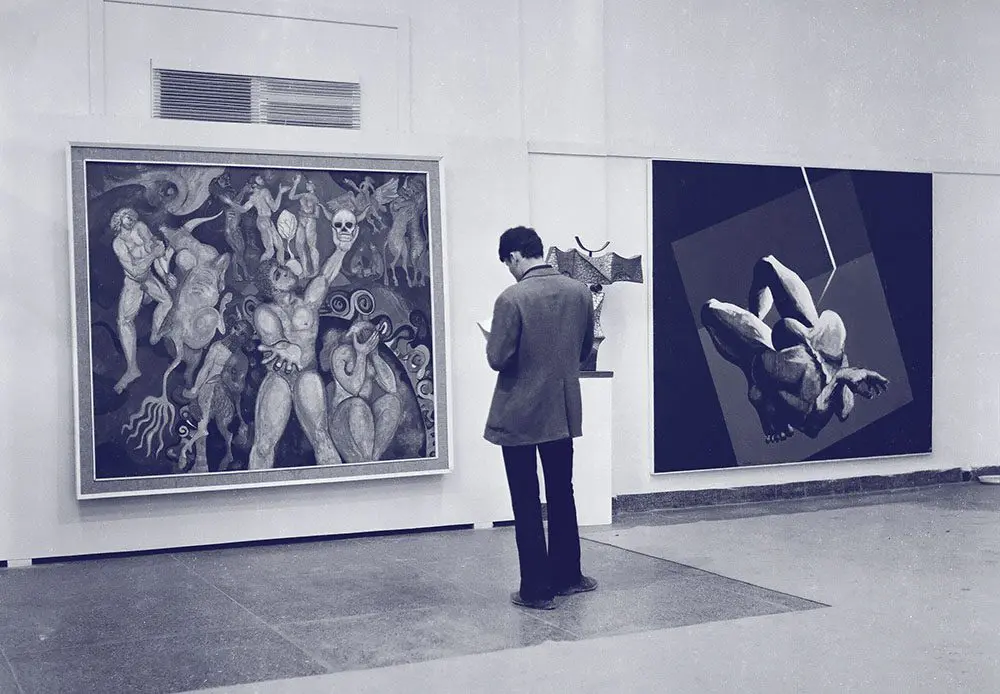
The First Biennale of Arab Art, in 1974 in Baghdad. This photo was taken in the Iraqi section, with paintings by Jawdet Haseeb on the right and Tariq Madhloum on the left.
In 1974, the fledgling Union of Arab Artists organised an art exhibition in Baghdad, the Biennale of Arab Art, to showcase contemporary Arab artists, who came from Iraq, Algeria, Morocco, Qatar, Kuwait and South Yemen. It was an era of renaissance in the Arab world, with such milestones as the independence a few years earlier of the UAE, Bahrain, and Qatar, and the Arab oil embargo that showed the centrality of the region in the global economy. Yet Arab artists were mostly absent from cultural capitals like London, New York or Paris.
The Biennale’s existence was important “due to the absence of a relationship between Arab artists, as there is no comprehensive journal for artistic activity in every country and there is no follow up of Arab artists in the diaspora, which makes it difficult for the follower of art history to know what is new,” says Dia Al Azzawi, an Iraqi painter and sculptor, and one of the event’s original organisers. “What [was] striking at the time is how enthusiastic the artists were to meet and ask questions among themselves.”
The idea for the Biennale was born at the Al Wasiti Fine Arts Festival in Baghdad in 1972, to create the first art festival to invite Arab artists.
“As a result of discussions between artists, it was proposed to organise an Arab edition every two years,” Al Azzawi says. Three editions were held, in Baghdad, Rabat and Tripoli.
The Biennale of Arab Art wasn’t the first in the Arab world, which already had the Alexandria Biennale for Mediterranean Countries, founded in 1955, but which was westward oriented. However, Baghdad was one of the earlier biennials after the original, in Venice, which began in 1895. It also was the first itinerant event, 20 years before the European equivalent, Manifesta, says Amin Alsaden, a curator, educator and scholar who has written extensively about Arab art.
“One of the earliest and most important regional biennials, a nomadic model that initially convened in Baghdad, it was meant to roam the Arab world in subsequent editions. The purpose of the First Biennale of Arab Art, as it was called, was clear: to bring the region together, to celebrate Arab art and artists, and to redefine the place of Arab art globally. I am not aware of a contemporary biennial in Arab countries that has a similar commitment—most existing models are about importing art from the rest of the world, with some regional participation, if any,” Alsaden says.
Rafal Niemojewski, executive director of the Biennial Foundation, sees advantages to having a mix of local and international artists, such as giving them an opportunity to rub elbows. And “for the local audience, where there’s no major museum, unless they travel to London or Paris, they don’t see the latest contemporary art,” without a biennial, he says. The optimum mix might bring in international works for the local crowd but also plenty of homegrown talent—curators and international art critics “don’t want to travel to see the same art as in New York. They want to see the local, to see something new. Biennials are important showcases for local art. This is how they get discovered. It’s a way to start international careers.”
Some high-profile Arab artists saw their careers kicked into higher gear thanks to exposure in the region’s biennials. Abdulnasser Gharem, a Saudi artist whose work appeared in the Sharjah Biennial in 2007 (and then others, including Venice in 2009 and 2011) recently became the highest-selling artist living in the Gulf when his installation Message/Messenger sold for a record price at auction.
“Access, access, access,” says Charles Pocock, art buyer and managing partner of Meem Gallery in Dubai. But biennials don’t just help artists—they give the entire artistic ecosystem a big boost.
Often, though not always, biennials precede the creation of an art academy or art museum in a city. One reason for this progression is the time and money required to build a museum and its collection. But even when a city has a museum for contemporary art, its biennial can continue to thrive, because the institutions fill such different roles. Museum collections are static, and special exhibitions can take as long as five years to organise. By contrast, a biennial comes together in about a year and looks forward.
“Biennials usually bring together artists around a specific theme or concept determined by the curator(s), and these artists might present brand new work as a response,” Alsaden says. “Biennials are usually more concerned with taking the pulse of the contemporary art world, or how it might address specific issues, so they become forums of sorts, exploring current preoccupations.”
At a biennial, “there is an expectation to be edgy, political and relevant,” Niemojewski says. “But you have to be diplomatic as a curator. It’s not necessarily about shock value but about shedding new light on an issue, within the frame of what is allowed in a culture.”
Politics have threaded through biennials’ pasts—especially those in the Arab world. During the Cold War, biennials gave artists and others an opportunity to get travel visas and to mingle with people they were otherwise forbidden to speak to. Egyptian President Gamal Nasser created Alexandria’s biennale in a soft-power statement about his then-young government and also to provide a neutral territory where Communist and non-Communist countries could meet.
“Whatever you produce in art and culture it will somehow be related to the political agenda,” says Beral Madra, an art critic and curator who curated the first and second Istanbul Biennials, in 1987 and 1989, as well as exhibitions of Turkish artists at numerous Venice Biennales. “The main character of the biennale should be to present the public a different way of thinking and interpreting the world affairs, problems and multifarious events that influence [the] global status of mankind.”
The first Istanbul Biennial, in 1987, “founded its main concept on artist’s presence rather than national presence,” Madra adds. The Istanbul Biennial “represented the post-colonial discourse of the non-West. With its at that time peripheral and isolated character it succeeded in performing its function to go off the road and to rebel.”
Biennials proliferated globally in the 1990s, including Sharjah’s, which launched in 1993. “Sharjah started from nothing and was first for the region,” Pocock says. More recently, Saudi Arabia launched the Diriyah Contemporary Art Biennale in 2021 and is holding an Islamic Arts Biennale in Jeddah until April. Some biennials, like the Biennale of Arab Art, fail to survive. The highly regarded Marrakech Biennale ran only from 2004 to 2016.

